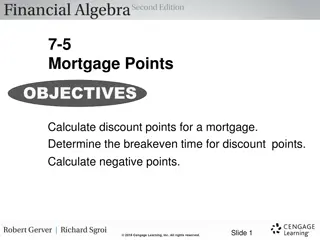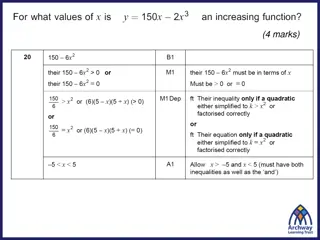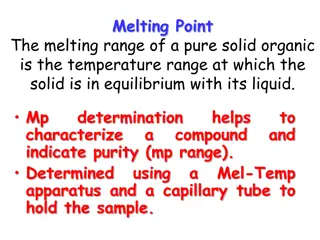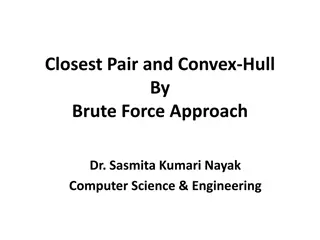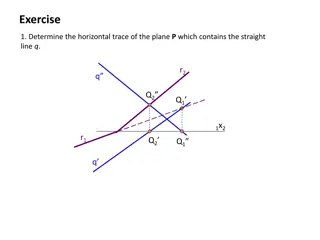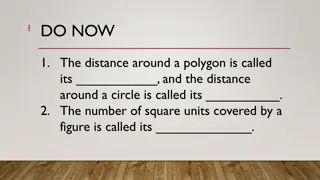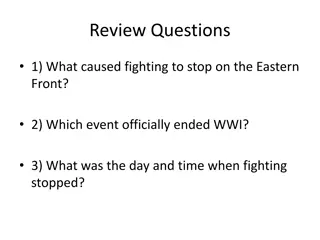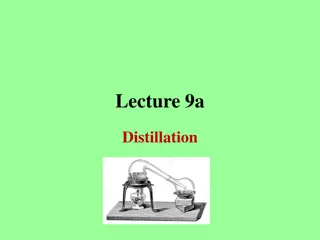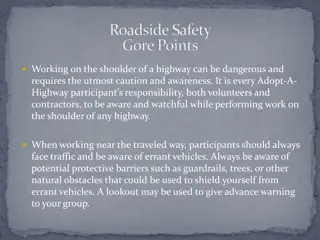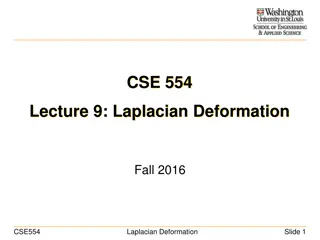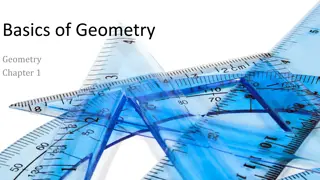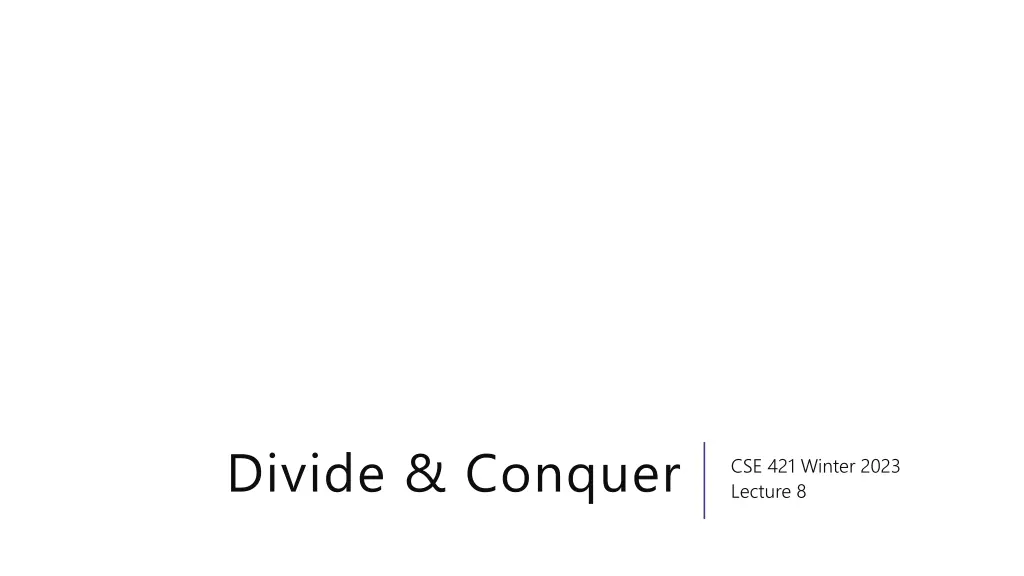
Winter 2023 Lecture Series: How Divide and Conquer Algorithm Solves Problems Efficiently
Explore the Divide and Conquer paradigm in CSE 421 Winter 2023 Lecture 8, focusing on using recursion for problem-solving efficiency. Dive into Dynamic Programming, learn classic algorithms, and discover the power of recursive thinking. Journey through examples like Merge Sort and solving problems with recursive magic. Uncover the basics of Divide and Conquer, analyzing algorithms' runtimes and stability. Delve into initial problem-solving steps with points in 2-dimensions and calculating distances efficiently.
Download Presentation

Please find below an Image/Link to download the presentation.
The content on the website is provided AS IS for your information and personal use only. It may not be sold, licensed, or shared on other websites without obtaining consent from the author. If you encounter any issues during the download, it is possible that the publisher has removed the file from their server.
You are allowed to download the files provided on this website for personal or commercial use, subject to the condition that they are used lawfully. All files are the property of their respective owners.
The content on the website is provided AS IS for your information and personal use only. It may not be sold, licensed, or shared on other websites without obtaining consent from the author.
E N D
Presentation Transcript
Divide & Conquer CSE 421 Winter 2023 Lecture 8
This Week Divide and Conquer. Using recursion to solve problems efficiently. Start on Dynamic Programming (a 2+ week adventure in using recursive thinking to solve problems efficiently). Classic, beautiful algorithms. Goal: see how far recursive thinking can take you. Today: What is D&C? A classic D&C example Define our problem for Wednesday
Divide & Conquer Algorithm Design Paradigm 1. Divide instance into subparts. 2. Solve the parts recursively. 3. Conquer by combining the answers You ve seen Divide & Conquer before!
Merge Sort https://www.youtube.com/watch?v=XaqR3G_NVoo Divide 0 1 2 3 4 5 6 7 8 9 8 2 91 22 57 1 10 6 7 4 5 6 7 8 9 0 1 2 3 4 1 10 6 7 4 8 2 91 22 57 Sort the pieces through the magic of recursion magic Combine 5 6 7 8 9 0 1 2 3 4 1 4 6 7 10 2 8 22 57 91 0 1 2 3 4 5 6 7 8 9 1 2 4 6 7 8 10 22 57 91 CSE 373 19 SU - ROBBIE WEBER 4
0 1 2 3 4 Merge Sort 8 2 57 91 22 0 1 0 1 2 8 2 57 91 22 mergeSort(input) { if (input.length == 1) return else smallerHalf = mergeSort(new [0, ..., mid]) largerHalf = mergeSort(new [mid + 1, ...]) return merge(smallerHalf, largerHalf) } 0 1 0 0 0 91 22 2 57 8 0 0 22 91 0 1 1 if n<= 1 2T(n/2) + n otherwise = ?(?log?) Worst case runtime? T(n) = 22 91 Best case runtime? Same 0 1 0 1 2 2 8 22 57 91 Average runtime? Same Yes Stable? 0 1 2 3 4 2 8 22 57 91 No In-place?
Our First Problem Given: Given: A list of points in 2-dimensions Return: Return: The distance between the two points that are closest to each other.
Our First Problem Baseline Given: Given: A list of points in 2-dimensions Return: Return: The distance between the two points that are closest to each other. What s the first algorithm you can think of? What s its running time?
Our First Problem Baseline Given: Given: A list of points in 2-dimensions Return: Return: The distance between the two points that are closest to each other. What s the first algorithm you can think of? What s its running time? Just calculate the distance between all pairs. ?2. Keep in the back of your minds: if we aren t doing better than ?2 we haven t made any progress.
An Easier Version Given: Given: A list of points in 1 1-dimension Return: Return: The distance between the two points that are closest to each other. Your input will be a list of doubles (in no particular order). What s your algorithm?
An Easier Version Given: Given: A list of points in 1 1-dimension Return: Return: The distance between the two points that are closest to each other. Your input will be a list of doubles (in no particular order). What s your algorithm? Sort the list! Find the minimum dist(A[i], A[i+1]) Correctness: Running time:
An Easier Version Given: Given: A list of points in 1 1-dimension Return: Return: The distance between the two points that are closest to each other. Your input will be a list of doubles (in no particular order). What s your algorithm? Sort the list! Find the minimum dist(A[i], A[i+1]) Correctness: After sorting, closest elements must be consecutive. Running time: ?(?log?) + ? ? = ?(?log?).
Back to the main problem. Baseline is ?2 1D version is (?log?) 2D Closest Points Given: Given: A list of points in 2-dimensions Return: Return: The distance between the two points that are closest to each other.
Back to the main problem. Baseline is ?2 1D version is (?log?) 2D Closest Points Need to Divide and Conquer. How do we divide?
Back to the main problem. Baseline is ?2 1D version is (?log?) 2D Closest Points Need to Divide and Conquer. How do we divide? Median in one dimension seems like a good spot to split!
Pseudocode double 2DClosestPoints(P[1..n]) if(? 100) //pick a cutoff you like; doesn t matter for big-? check all possible pairs, return the smallest distance. Sort P[] by ?-coordinate ? min{2DClosestPoints(P[1..n/2]), 2DClosestPoints(P[n/2+1,n])} //TODO: conquer
2D Closest Points Are we done? Just return ?? 17 13
2D Closest Points Are we done? Just return ?? No! What if the closest pair goes from the left to the right? 17 13 8
Conquer Can we just check every pair that goes from the left to the right?
Some Questionable Pseudocode double 2DClosestPoints(P[1..n]) if(? 100) //pick a cutoff you like; doesn t matter for big-? check all possible pairs, return the smallest distance. Sort P[] by ?-coordinate ? min{2DClosestPoints(P[1..n/2]), 2DClosestPoints(P[n/2+1,n])} for(? from 1 to ?/2) for(? from ?/2+1 to ?) ? min{?, dist(P[i],P[j])} return ?
Conquer Can we just check every pair that goes from the left to the right? Well it d, give us the right answer, but The key to divide & conquer is making sure the conquer step is a faster calculation than brute force. Otherwise it s brute force all the way down!
Some Questionable Pseudocode The Questionable Code on the last slide is equivalent to ? for(? from 1 to ?) for(? from ? + 1 to ?) ? min{ dist(P[i],P[j]) } Literally. They both check every possible ?,?. The questionable code just does the checks in a different order! We need to use the results of our recursive calls to narrow down the problem! How does ? help?
Deep Breath Where were we? We found the median, made two recursive calls. We need to see if there is a pair with one point on the left, the other on the right, with a closer distance than the recursive calls gave. And we need to do it without looking at all possible pairs.
Pseudocode double 2DClosestPoints(P[1..n]) if(? 100) //pick a cutoff you like; doesn t matter for big-? check all possible pairs, return the smallest distance. Sort P[] by ?-coordinate ? min{2DClosestPoints(P[1..n/2]), 2DClosestPoints(P[n/2+1,n])} //TODO: conquer
2D Closest Points Conquer: Find the closest crossing pair. 17 13 Do we really need to check this point? 8
Pseudocode double 2DClosestPoints(P[1..n]) if(? 100) //pick a cutoff you like; doesn t matter for big-? check all possible pairs, return the smallest distance. Sort P[] by ?-coordinate ? min{2DClosestPoints(P[1..n/2]), 2DClosestPoints(P[n/2+1,n])} //TODO: conquer Idea: We only care about a particular point if it is distance ? or less from the dividing line. Otherwise it can t possibly be in a crossing pair.
2D Closest Points Do we need to check every pair? Only care if distance is less than ?. (Won t be right answer otherwise) 17 13 ? = 13
2D Closest Points Can ignore the shaded regions. Only candidates are in the narrow strip. 17 13 ? = 13
Conquering In that example, we made the problem smaller because there were fewer points That doesn t always happen. But we ve still made our problem easier! How? Are problem is almost one-dimensional.
Almost One-Dimensional If the problem were really check adjacent elements. I.e. if P[i], P[j] were the closest points, then ? ? = 1. really one-dimensional, we could just sort and We can get pretty close. 11 is a constant. Independent of ? If dist(P[i],P[j])< ? and P[i], P[j] are both in the middle strip, then ? ? 11 Intuition: two points on the left must be at least ? from each other. Only so much room in a 2? wide-strip to fit points in ? height too.
Pseudocode double 2DClosestPoints(P[1..n]) if(? 100) //pick a cutoff you like; doesn t matter for big-? check all possible pairs, return the smallest distance. Sort P[] by ?-coordinate ? min{2DClosestPoints(P[1..n/2]), 2DClosestPoints(P[n/2+1,n])} Let ? be all points within ? of the median in ?-coordinate. Sort ? by ?-coordinate for(? from 1 to ?.length) for(? from ? + 1 to ? + 11) ? min{dist(?[?], ?[?]), ?} return ?
Prove the Lemma If dist(P[i],P[j]) ? and P[i], P[j] are both in the middle strip, then ? ? 11 Place a grid of ?/2x?/2 squares on the strip. Strip is 4 squares wide. ? 2 ? 2
Prove the Lemma If dist(P[i],P[j]) ? and P[i], P[j] are both in the middle strip, then ? ? 11 Place a grid of ?/2x?/2 squares on the strip. Only one point in each cell. 2 2 ? 2 ? 2 dist ?2= ?. 2 ?2/4 < + = But ? is the smallest distance between points on the same side (found via recursive calls).
Prove the Lemma If dist(P[i],P[j]) ? and P[i], P[j] are both in the middle strip, then ? ? 11 Place a grid of ?/2x?/2 squares on the strip. Only one point in each cell. Two points in the same cell are on the same side and distance < ?.
Prove the Lemma If dist(P[i],P[j]) ? and P[i], P[j] are both in the middle strip, then ? ? 11 Place a grid of ?/2x?/2 squares on the strip. Only one point in each cell. Two points in the same cell are on the same side and distance < ?. If two points have distance <?, they are in the same row, adjacent rows, or have one row between them. ? Two rows between gives ? distance in the ?- coordinate.
Prove the Lemma If dist(P[i],P[j]) ? and P[i], P[j] are both in the middle strip, then ? ? 11 Place a grid of ?/2x?/2 squares on the strip. Only one point in each cell. Two points in the same cell are on the same side and distance < ?. If two points have distance <?, they are in the same row, adjacent rows, or have one row between them. How far apart can those points be in the array? Only 12 elements can be in those rows, so when ordered by ?-coordinate, difference is at most 11.
It works! A formal proof of correctness would be by induction. Idea for IS: Closest pair in overall instance is in one half, the other, or split. By IH, recursive calls give distance between closest pairs in each half. Case 1: closest pair is in a half, Recursive call gives true shortest distance, by IH. ? will never be overwritten because we only compare to other distances between points. Case 2: closest pair crosses, Then its distance is less than the (correct) distances found by the recursive calls. By lemma, we will check the closest pair, and since we take the min, ? will be set to that value and (because we only compare to other distances) never overwritten. In both cases we return the true shortest distance.
Write a recurrence for the running time double 2DClosestPoints(P[1..n]) if(? 100) //pick a cutoff you like; doesn t matter for big-? check all possible pairs, return the smallest distance. Sort P[] by ?-coordinate ? min{2DClosestPoints(P[1..n/2]), 2DClosestPoints(P[n/2+1,n])} Let ? be all points within ? of the median in ?-coordinate. Sort ? by ?-coordinate for(? from 1 to ?.length) for(? from ? + 1 to ? + 10) ? min{dist(?[?], ?[?]), ?} return ?
Write a recurrence for the running time double 2DClosestPoints(P[1..n]) if(? 100) //pick a cutoff you like; doesn t matter for big-? check all possible pairs, return the smallest distance. Sort P[] by ?-coordinate ? min{2DClosestPoints(P[1..n/2]), 2DClosestPoints(P[n/2+1,n])} Let ? be all points within ? of the median in ?-coordinate. Sort ? by ?-coordinate for(? from 1 to ?.length) for(? from ? + 1 to ? + 10) ? min{dist(?[?], ?[?]), ?} return ? (?log?) Recursive calls size ?/2 (?log?) ?(?) iterations ?(1) per iteration
Running Time ? 1 if ? 100 ? ? = ? 2 2? + ?(?log?) otherwise How did I find this closed form? For today, just believe it, we ll give you a tool on Friday. ?(?log2?) Small optimization: just sort by ? and ? once, and store the sorted versions. ? 1 if ? 100 ? ? = ? 2+ ?(?) 2? otherwise ?(?log?) for sorting, ?(?log?) for everything else; total ?(?log?).
It works! Note that ?/2 grid thing was just pseudocode, the grid isn t there. just for the proof. Look back at the
Takeaways A clever algorithm for finding closest points. To make divide & conquer efficient, your conquer step must be faster than brute forcing the crossing pairs. Look for how the problem becomes simpler.




